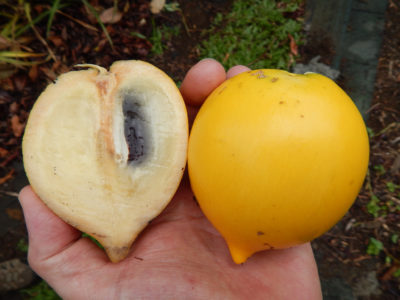
Abiu - Photo by Forest Starr and Kim Starr
Abiu is a tropical fruit originating from the Amazon rainforest, thriving in warm, humid climates. The bright yellow fruits have a sweet, translucent, jelly-like flesh with a distinctive, subtle caramel flavor. It’s best enjoyed fresh and chilled, or added to desserts and smoothies for a refreshing, naturally sweet treat.
Names
Scientific
Pouteria caimito
Synonym
Achras caimito
Lucuma caimito
English
Abiu
Yellow star apple
Dutch
Abiu
Spanish
Caimito
Caimito amarillo
Italian
Caimito
Taxonomy
Order
Ericales
Family
Sapotaceae
Genus
Pouteria
Species
Pouteria caimito (Abiu)
Basic information and facts
Origin:
Abiu is native to the Amazon rainforest region of South America, particularly areas of Peru, Ecuador, Venezuela, and Brazil. It has been cultivated by indigenous tribes for thousands of years.
Distribution:
While native to the Amazon, Abiu is now cultivated in other tropical and subtropical regions globally, including parts of Florida (USA), Northern Australia, Southeast Asia (like the Philippines and Malaysia), and Hawaii.
Annual, biennial, or perennial:
Abiu is a perennial tree.
Flowers:
Abiu trees produce small, white to greenish-white flowers that appear in clusters or singly in the leaf axils. Flowers possess both male and female parts.
Leaves:
The tree has evergreen, alternate, oblong to elliptic leaves, typically 10-20 cm (4-8 inches) long, with a leathery texture.
Fruits:
The fruits are typically round to oval, turning a vibrant yellow when ripe. They have a smooth, leathery skin (inedible) and contain a translucent, gelatinous, custard-like flesh with a sweet, subtle caramel or vanilla flavor. Each fruit can contain 1 to 4 large, dark brown seeds.
Climate and weather:
Abiu thrives in warm, humid, tropical climates with consistent rainfall. It is very sensitive to cold temperatures and frost, and does not tolerate prolonged dry periods or strong winds well.
Pollination:
Abiu flowers are generally cross-pollinated, often by insects such as bees.
Height:
In its native habitat, the Abiu tree can reach up to 15 meters (50 feet) or more, but cultivated trees are often kept smaller, typically around 5-10 meters (15-30 feet), for easier harvesting.
Spacing:
Recommended spacing for Abiu trees can vary but generally ranges from 5-10 meters (16-33 feet) between trees to allow for adequate growth and air circulation.
Propagation:
Abiu is most commonly propagated from seeds, which germinate relatively quickly. Grafting is also a preferred method for commercial cultivation as it ensures consistent fruit quality and can lead to earlier fruiting.
Harvesting:
Abiu fruits are typically harvested when they turn bright yellow and feel slightly soft to the touch. They should be picked when fully ripe, as they generally do not ripen well off the tree..
Uses:
The primary use of Abiu is for its delicious fresh fruit, often eaten chilled by scooping out the pulp. It’s also popular in desserts, ice cream, smoothies, and fruit salads. Medicinally, some traditional uses include treating coughs, bronchitis, and digestive issues.
Crop categories
Fruits
Minor crops
Tropical crops
Pictures

Abiu fruits
Pouletic [CC BY-SA 3.0], from Wikimedia Commons
